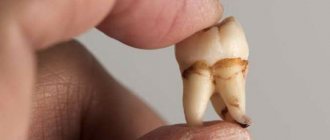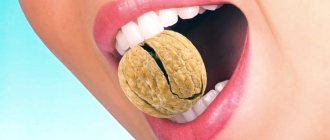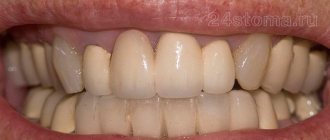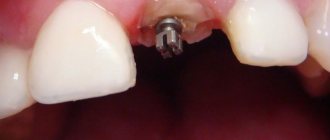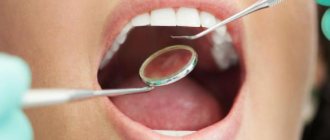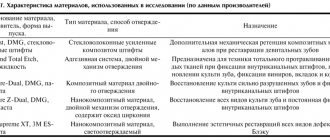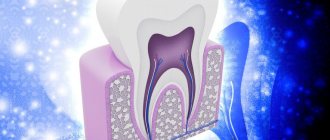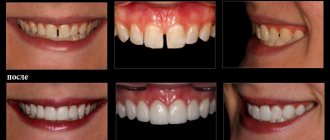Often dental problems can be solved without tooth extraction. Currently, dentistry makes it possible to keep your own teeth even in cases where serious diseases or destruction are observed in the area. However, in some situations you still cannot do without deletion.
In what cases is it necessary to remove a front tooth?
- Purulent periodontitis without the ability to apply standard methods,
- The presence of a dental infection due to sinusitis, periostitis, osteomyelitis, phlegmon, etc.
- Fracture of the coronal part of the tooth with exposure of the pulp and infection,
- Unsuccessful use of endodontic treatment of chronic periodontitis,
- Sufficient damage in the area of the coronal part of the tooth without the possibility of using its base to create a prosthesis,
- Fully or partially impacted teeth that cause inflammation. Removal is necessary if the standard solution does not help,
- Severe periodontitis with grade 3 mobility,
- The location of the tooth in the jaw fracture gap,
- The presence of teeth in excess of the norm, interfering with the chewing process or causing pain in the oral cavity.
Indications for removal of baby teeth
It is necessary to remove baby teeth if there are relative or absolute indications. The following are absolute:
- Serious tooth damage caused by caries (without the possibility of restoration),
- A temporary tooth prevents the growth of a molar,
- Formation of a cyst at the base of the tooth,
- Pulpitis or periodontitis, which can lead to the death of the molar tooth germ.
In addition to absolute indications, relative indications are also distinguished in order to remove a baby tooth. Extraction is necessary if there is a tooth fracture, the baby tooth causes discomfort, pain or interferes with eating.
The process of removing baby teeth is significantly different from extracting permanent teeth. This is explained by the fact that the structure of teeth in a child and an adult has its own characteristics that must be taken into account. Primary teeth have thin alveolar walls and longer, thinner roots than molars. In most cases, anesthesia is not required when working with baby teeth. If the temporary tooth is already loose, you can do without anesthesia. Anesthesia is used exclusively for pulpitis or periodontitis.
How is complete tooth extraction performed?
When it comes to complete tooth extraction, this does not mean that all dental units are removed in one visit. It all depends on the clinical situation, namely:
- how many teeth are preserved in the oral cavity;
- how badly they are affected.
Dentists recommend removing no more than three teeth in one visit. However, in a situation where teeth affected by periodontal disease are severely loosened and their root system is exposed by more than half, it is possible to simultaneously remove all affected teeth. This is due to the fact that in this clinical situation the removal procedure is carried out very quickly and is not accompanied by severe blood loss. In this case, no stitches are even applied, just tight tampons covering the wound and hemostatic agents are enough.
If all the teeth are preserved in the oral cavity, but they are affected by periodontal disease, or if prosthetics are the indication for their removal, then the removal is carried out in 8–9 visits. In most cases, removal is performed under local anesthesia, but if there is an allergy to the components of the anesthetic, then general anesthesia is indicated. In this case, they try to remove as many teeth as possible in one procedure.
The final healing of the extracted tooth socket occurs within 3 - 4 weeks. In case of complete prosthetics, to ensure good fixation of the prosthesis, the impression can be taken only after complete healing. Otherwise, protrusions will remain on the inner surface of the prosthesis in places of unhealed wounds, and these protrusions will injure the soft tissues of the oral cavity.
Features of extraction of anterior teeth
Depending on the condition of the tooth root and bone in a given area, various methods are used.
- Removal of upper front teeth
The upper incisors have a cone-shaped, rounded root, which makes it better to remove them using rotation. If rotation does not allow reaching the tooth, then it is first rocked and then the rotation method is used. In this case, the tooth becomes slightly looser in the socket and it is much easier to get it out.
- Removal of lower front teeth.
The structure of the lower incisors differs from the upper ones: such teeth have a straight, thin root, which is compressed on both sides. Teeth on the lower jaw are removed using rocking. First, the tooth is moved to the lip (where the bone is thinner), and then moved to the tongue.
How to pull out a tooth yourself
What do you need to know if you want to remove a tooth yourself? Firstly, that it is not difficult to do, and secondly, that it can be done at home and on your own. True, there is one “but”...
Pulling out a tooth yourself at home is only permissible in situations where the tooth is loose. If the tooth is immovable, it is not recommended to remove it yourself; it is better to contact your nearest dentist.
So, let's proceed to self-removal of the tooth:
Tooth extraction at home: not scary
- Disinfection . It is necessary to brush your teeth, rinse your mouth (for example, with regular mouthwash), and wash your hands thoroughly with soap and water.
- Pain relief . You can numb the gums using a special gel based on 10% or 5% lidocaine, which is sold in pharmacies (if you are going to remove a child’s tooth), adults can take a regular painkiller against toothache. If you want maximum effect, you can use tramadol or etoricoxib (these types of painkillers cause tissue numbness).
- Tools . Since our tooth is loose and is about to fall out, under no circumstances should you use forceps or other similar objects (this can only be done by a dentist). All your equipment is a sterile bandage .
- Process . Wrap a sterile bandage around your fingers and grab the tooth tightly, shaking it from side to side. Then try to twist. After such manipulations, you must make sure that the tooth begins to move more freely and is about to fall out. Only then can you make a sharp and confident movement to extract the tooth - this will take less than a second. If you don't succeed the first time, try several times.
Have you extracted a tooth? Great! But that's not all. Press a piece of sterile gauze onto the area where the tooth was removed to stop the bleeding. Do not keep the gauze for long. A blood clot will very soon form under it, which will be able to stop the bleeding on its own. Just do not remove the gauze with a jerk, so as not to damage the formed clot.
No further specific actions are required after a successful tooth extraction operation; hour after hour, the wound will “heal itself.” All you need to do in the following days is to closely monitor the hole that appears in your mouth for signs of infection. If you notice anything wrong, contact your dentist immediately for dental care.
Actually, that's all!
Removing a tooth yourself is not difficult. If you are not decisive, you will always get help at the nearest dental clinic. Moscow metro station Zvezdnaya, Danube Avenue, 23
Rules for oral care after surgery
In order to avoid bleeding, it is necessary not to rinse the mouth and refrain from eating for three hours after completion of the operation. Before tooth extraction, the patient is contraindicated to drink hot foods or take a bath. In addition, it is advisable to avoid intense sports activities during this time.
After the dental procedure, you should practice good oral hygiene for several days. After eating food, it is necessary to rinse the mouth with an antiseptic.
Indications for tooth extraction (extraction):
- Purulent periodontitis, which does not respond to conservative treatment;
- If the tooth is the source of an infectious process with sinusitis, periostitis, osteomyelitis, phlegmon, abscess, etc.;
- Fracture of the tooth crown with exposure and infection of the pulp;
- Failure of endodontic treatment of chronic periodontium;
- Complete destruction of the crown, inability to use the tooth root for prosthetics;
- Impacted or partially impacted teeth, causing inflammation in nearby tissues that cannot be treated;
- III degree mobility in severe periodontal disease;
- Teeth located in the jaw fracture gap;
- Supernumerary teeth that interfere with chewing function or cause pain.
Molar tooth extraction procedure
The procedure will be the same in every dentistry. With high-quality modern equipment, the procedure is quick and painless. If a patient is afraid to have a tooth removed, then he must understand the consequences that such a decision will entail. One of them is pain, which may be stronger than after surgery under anesthesia.
Removal steps
How to pull out a molar, 8 stages of work:
- Examination and diagnostic procedures.
- Anesthesia of nearby areas.
- Ligamentotomy.
- Moving the forceps under the gum.
- Dislocation.
- Extraction.
- Inspection and treatment of the resulting hole.
- Stitching.
If the impacted figure eight is removed, then an additional tissue incision will be required. In this case, the gums are sutured after the molar is removed, and complete healing will take more time.
Until the next visit to the dentist, how the molar heals after removal should be monitored by the patient himself. If any unusual pain occurs, the dentist who performed the procedure should be contacted.
Anesthesia
Local anesthesia is necessary to increase patient comfort. It is inserted before the molar tooth is removed. But not all drugs have the same effect on the human body. Painkillers are divided into groups:
- Application – suitable only for simple procedures. Not used when working with adults.
- Infiltration – suitable for simple procedures, can be used to remove mobile incisors and molars.
- Conductive – used when complex removal is necessary or for complex work. Allows you to block the peripheral branches of the nerve to cover a large area.
- Intraosseous – the anesthetic is injected directly into the bone tissue, leaving the surrounding soft tissue sensitive.
- Intraligamentary – mainly used when working with children.
When selecting an anesthetic, the doctor should always find out about the presence of an allergy to any compound in order to select the correct composition for anesthesia. Thanks to these drugs, the patient does not have to wonder whether it hurts to remove a tooth.
Is it painful to remove a tooth root?
Thanks to modern anesthesia methods, the procedure is painless. Does it hurt to have a tooth pulled out? No, and discomfort appears only after the painkiller wears off.
Result of prosthetics
To restore the aesthetics of the front teeth, 3 visits to the clinic were required (1- consultation with a dentist and periodontist, 2- cleaning and preparation of teeth, 3- securing a bridge). Within 7 days all work was completed. For the bridge prosthesis, the Sculpture FiberKor ceromer was used. The cost of the entire range of dental services was 40,950 rubles. The result is a great-looking smile.
Dental treatment at Dial-Dent means precise planning of the number and duration of visits, as well as drawing up an estimate for treatment, indicating the cost of each stage of work, and appointments at the appointed time. This approach makes treatment convenient for patients with busy work schedules, as it allows them to clearly plan their time and finances. A special feature of Family Dentistry is the solution of complex cases using the most advanced technologies in dentistry, the availability of the necessary diagnostic equipment and various specialists in one clinic.
See other examples of treatment, implantation and dental prosthetics at Dial-Dent here.
Make an appointment for a consultation by phone +7-499-110-18-04 or through the form on the website. You can ask questions about dental treatment and prosthetics to the chief doctor of the clinic, Sergei Vladimirovich Tsukor, at
Preparation and planning of prosthetics
The option for urgent tooth restoration, which the patient saw on the website, is to install a fixed bridge prosthesis secured with a composite material to the adjacent teeth (more details about this work here). The disadvantage of this design is the lack of physiological pressure on the jaw bone during chewing load, as well as additional load on the supporting teeth. However, the undoubted advantage of this method is the speed of restoration of aesthetics, so this method is suitable as temporary prosthetics.
A large amount of dark plaque is visible on the teeth, which spoils the appearance of the teeth and does not allow one to determine their natural color. The patient underwent professional teeth cleaning with Air Flow (hygienist E.P. Smirnova), which significantly changed the appearance of the teeth, making them lighter by removing old plaque. Professional cleaning also improved the condition of the gums, as accumulated hard plaque and tartar in the cervical area of the teeth led to bleeding gums and bad breath.
After brushing the teeth, a diagnostic model was created. To secure the bridge, the orthopedic dentist tried to minimally grind the adjacent teeth in order to keep them alive. In this case, the prosthesis must hold securely. The turning depth was determined together with the dental technician using a diagnostic model.
After careful calculations, grinding is carried out on living teeth. After grinding the supporting teeth, a model was made for the manufacture of a bridge prosthesis on inlays in the Dial-Dent dental laboratory.
As a result of careful preparation and calculations, the teeth remained alive and the strength of the structure was ensured. Two models side by side show how the idea came to life.
The color of the denture was carefully selected.
The presence of our own dental laboratory significantly reduces the production time of dentures and increases their convenience, since in difficult cases the dental technician, together with the prosthetist and the patient, participates in the planning of denture structures.
A bridge prosthesis is a ceramic tooth with an imitation of a gum area, and lateral protrusions - inlays in the supporting teeth, thanks to which it is fixed.
The denture is made on a model, which ensures high precision and comfort.
The bridge is fixed on the inside of the teeth.
This option for restoring a lost front tooth allowed the patient to quickly return to work, maintaining the appearance of the teeth in an aesthetic condition. The prosthesis is firmly attached enough that you can eat almost any food without fear (it is not recommended to chew nuts and crackers).
The patient is consulted about possible methods of restoring the front tooth.
In the absence of one tooth, one of the best methods is dental implantation, which is carried out at the Family Dentistry by an experienced implant surgeon V.P. Alaverdov. using the most reliable implant systems. It is recommended to install a completely ceramic dental crown on an implant. All-ceramic crowns have enhanced aesthetic characteristics, which is very important for prosthetic teeth in the anterior region. A plan for dental implantation and implant prosthetics was drawn up, the required number of visits and their duration were outlined, so that the patient could plan his visits to the clinic in accordance with the work schedule.
